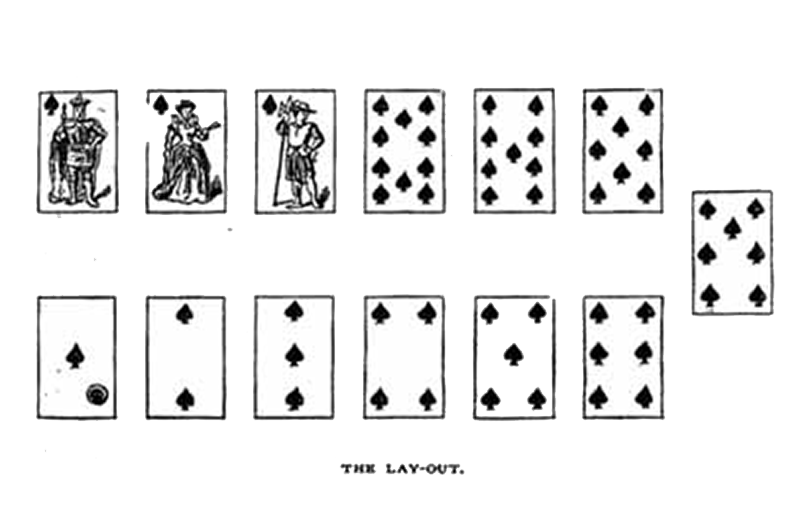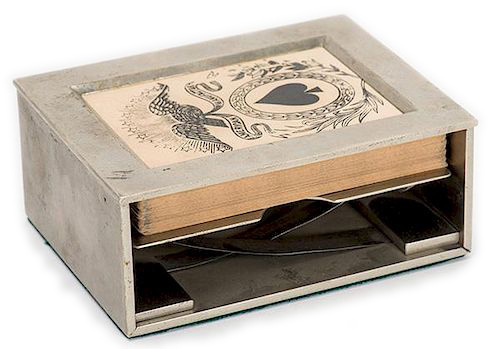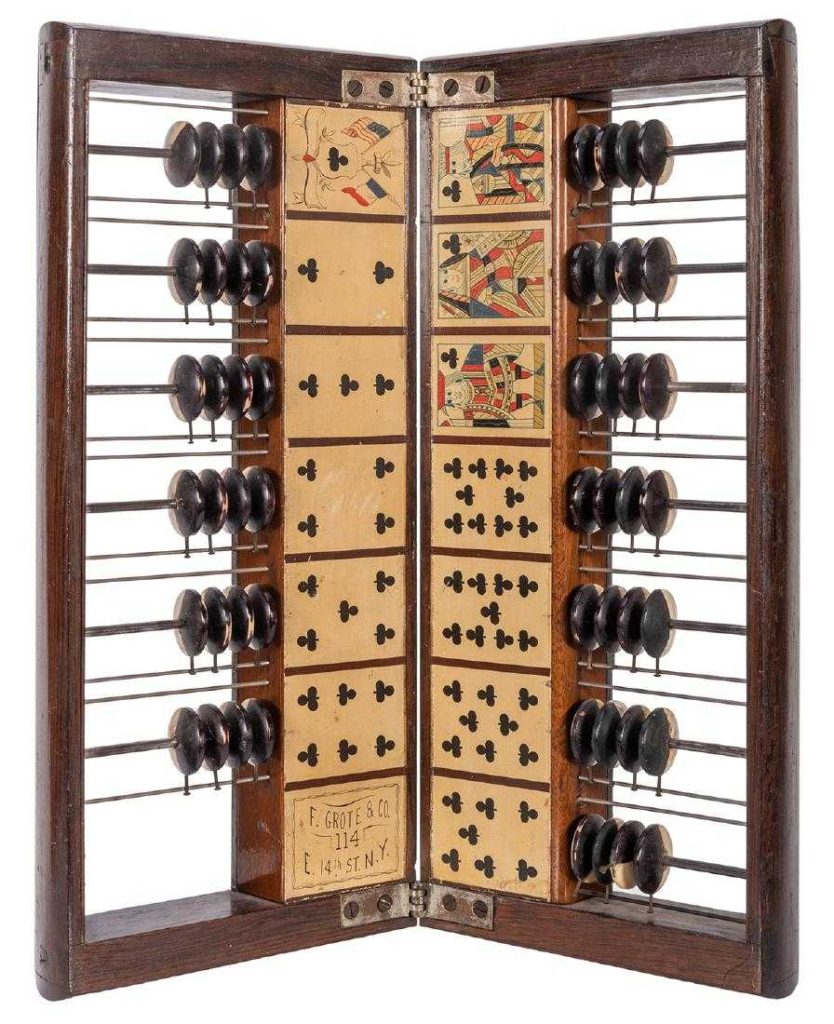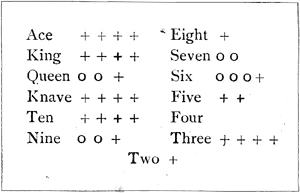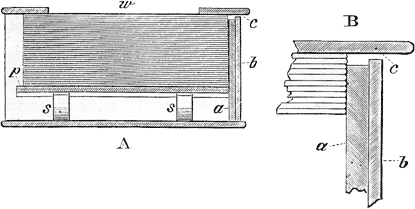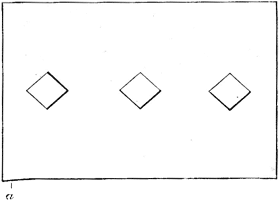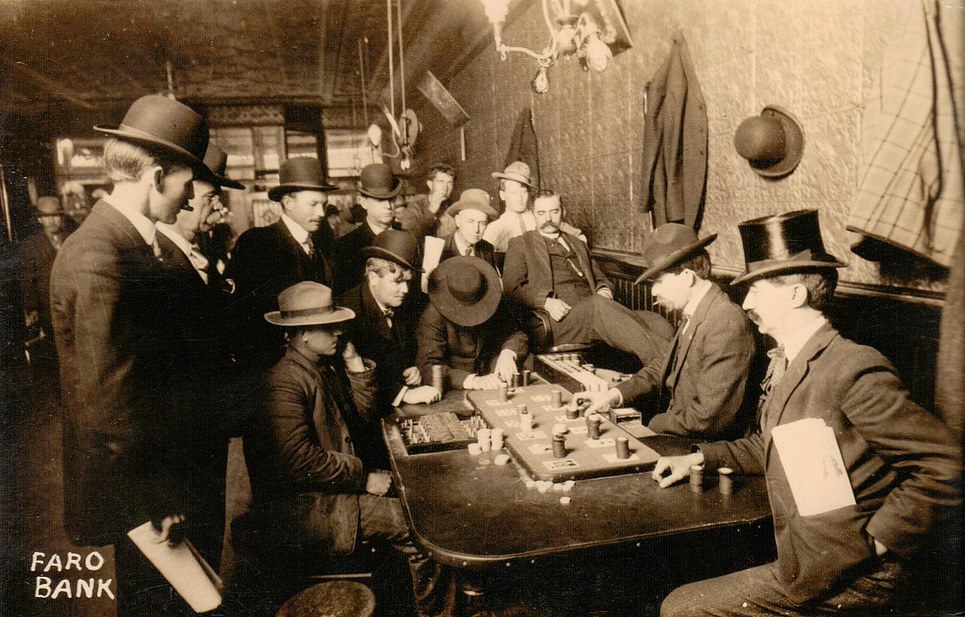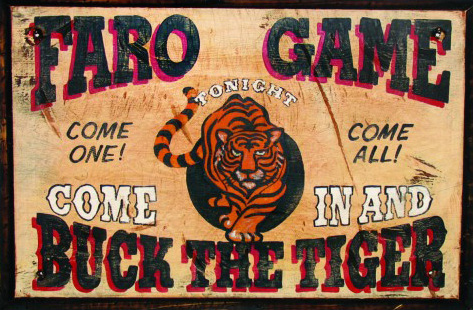Faro Rules
- At March 13, 2019
- By Great Quail
- In Deadlands, Rules
 0
0
Faro may almost be said to occupy in America the position of a national game. The methods of cheating used in connection with it are so numerous and so ingenious that it becomes really necessary to devote an entire chapter specially to them.
—John Neville Maskelyne, Sharps and Flats, 1894
Introduction
This document describes the game of faro in the context of Deadlands. After a discussion of the game’s importance to the Wild West, the rules of faro are explained, along with some ways to cheat at faro. This is followed by instructions on how to simulate a faro game in a Deadlands campaign, with suggestions on relating faro to a player character’s Gambling skill, and making this “game-within-a-game” more meaningful for the players themselves.
Faro History
Although most Western movies show gunslingers and cowboys hunkered over a poker table, poker was fairly obscure until after the Civil War. The most popular card game of the American West was faro. Arriving from Europe to New Orleans in the early eighteenth century, faro spread up the Mississippi like wildfire, and was soon played everywhere from mining camps to Eastern casinos. Some of the most famous names from Western lore were quite fond of the game. Wyatt Earp, Doc Holliday, and Belle Siddons were all faro dealers, and Wild Bill Hickok and Bat Masterson were avid devotées. By the 1880s, more money was wagered on faro each year than all other games of chance combined. The name “faro” is derived from a popular brand of French cards, which had an image of an Egyptian pharaoh on their backs. In America, most faro rigs were sold in a mahogany box sporting a Bengal tiger on the lid, which gave rise to the euphemisms “bucking the tiger” or “twisting the tiger’s tail” for playing the game. By the late 1800s, the image of a tiger had become synonymous with faro, and some gambling districts were simply called “Tiger Alley.” Despite its popularity, faro died out during the twentieth century, the victim of increasingly restrictive gambling laws. Another reason for the decline of faro is found in the nature of the game itself. The odds of the house making money on an honest game of faro are only slighter better than 50-50. By the early twentieth century, most saloons and casinos had exchanged faro for more profitable games.
Rules of the Game
Faro is a French variant of the Italian game bassetta, and like monte, lansquenet, and vingt-et-un, it requires a dealer or “banker.” Faro is a fast-paced game, and proceeds in turns with multiple players betting on the probability that a certain card will be drawn. In that way, it is similar to roulette; but the group psychology of the game has often been compared to craps.
Faro Basics
Faro is generally played on a green-baize “layout” with the entire suit of spades printed, lacquered, or pasted in a clockwise descending pattern:
These cards are not in play, but are merely representative of two random cards drawn by the dealer each turn. One card is the “losing card” and one is the “winning card.” Suit does not matter in faro, only the “case,” or face value, of each card. Players, sometimes called “punters,” represent their bets with “checks,” which resemble poker chips. At the beginning of a turn, players place their checks on the card they expect the dealer to turn up as the winning card. This is called “backing” or “flat-footing” the card. If they are correct, they get a 1-to-1 payoff. However, if their check is on the losing card, they lose that check to the dealer.
The Dealer’s Box
While early faro dealers simply shuffled the deck and placed it on the table, most nineteenth-century faro banks employ a spring-loaded “dealer’s box,” the ancestor of the modern dealer’s shoe. Invented in 1825 by a Cincinnati watchmaker named Graves, the dealer’s box was initially intended to prevent dishonest shuffles; in time, it became the primary instrument used to fleece players! The standard dealer’s box is a rectangle made from electrum or “German silver,” an alloy of nickel and copper popular with nineteenth-century gunmakers. The top of the box features a window. The front of the box features a slit just wide enough for a single card, while springs keep pressure on the deck from below. In some locales, dealing from a box is likened to cleaning a fish, and dealers are called “gut-pullers.”
Stakes
The dealer sets the stakes of a faro game, usually stating a minimum or maximum bet. Checks may be of a uniform denomination with different colors representing individual players; or colored by value and marked with player tokens. Early checks were made from ivory, which led to slang such as “snowballing” the table, or covering the cards with bets. In some wilder faro games, material objects may be offered for betting—coins, paper currency, pokes of gold dust, pocket watches, expensive revolvers, title deeds, wedding rings, and so on.
Playing the Game
A game of faro begins when the dealer draws the first card from the dealer’s box. This card is known as the “soda” and is immediately “burned off” or discarded, leaving 51 cards in the box. The dealer starts the turn by drawing two consecutive cards. The first card is the “losing card,” which is placed to the right of the box. This is more properly called the “dealer’s card.” Next, the “winning card” is drawn and placed to the left of the box. Formally named the carte anglaise, it’s also known as the “player’s card.” The dealer collects all checks placed the dealer’s card, and the players win bets placed on the player’s card, receiving a simple 1-to-1 payout. The remainder of the bets are considered a “push.” They are permitted to remain where they are, or may be collected and redistributed for the next turn. Faro is essentially a game of 50-50 odds.
Splitting
If the dealer draws a pair, or “doublet,” she wins half the bets placed on that card. This is called “splitting.” Theoretically, this is the only advantage the dealer has in faro, which makes unrigged games fairly unprofitable for the house. Early games of faro had dealers winning all checks placed on a doublet, but that practice was discontinued in the mid-nineteenth century.
Combination Bets
A player may increase his bet by placing checks on multiple cards, or split his bet by placing checks between two cards or at the junction of three or four cards. This increases the chance of winning, but equally increases the chance of losing. Three-card bets are marked by placing the check above a card on the top row, or below a card on the bottom row. This bet covers the marked card and its two neighbors. A check above the Queen is known as the “Big Figure,” a check below the Deuce is the “Little Figure.” A bet placed on the Six-Seven-Eight trio is called “the Pot.” Four-card bets, or “betting the squares,” are marked by placing a check at the junction of four cards. Traditionally, three squares are allowed. From left to right, these are the Grand Square (K-Q-A-2), the Jack Square (J-10-3-4), and the Nine Square (9-8-5-6). Other combinations include diagonal and corner bets, but these are later evolutions, and were not accepted in every house. Combination bets that cover both the winning and losing card are reckoned as a split; however some friendlier houses consider it a push.
Coppering
Most faro games involve “coppering.” This involves placing a copper penny on a check, which “reverses” the bet. If the dealer’s card shows that card, the bet is won; if the carte anglaiseturns up that card, the bet is lost. In casinos, hexagonal markers are used instead of copper pennies.
High Card
Most faro layouts have a “high card” marker printed at the top of the layout. A check placed on this changes the nature of the player’s bet, accepting a straight 50-50 chance that the player’s card will be higher than the dealer’s card. In faro, an Ace is considered a One, and is the lowest card. A High Card bet may also be coppered, transforming it into a low card bet.
Exotic Bets
Toward the end of the nineteenth century, dealers began accepting various forms of exotic bets, such as “Even vs. Odd,” “High vs. Low,” “Red vs. Black,” and so on. For the sake of Deadlands, such bets are up to the Marshal.
Ending the Game
Gameplay proceeds for twenty-four turns, until only three cards remain in the dealer’s box. The dealer invites players to “call the turn,” and players may predict the exact order of the remaining cards—the dealer’s card, the player’s card, and the final card, known as the “hock.” Successfully calling the turn is called “earthquaking,” and pays off 4-to-1. If the three remaining cards contain a doublet, it’s called a “cat hop” and payoff is just 1-to-1. If the final three cards are known to be a triplet, the game ends with no bets made. Bets on the turn are made separately, but this final round is also open to standard bets as well. Any checks left on the table after the hock are forfeited to the dealer, the origin of the phrase “in hock.” In fact, early games of faro gave any bets on the hock card automatically to the dealer.
Casekeeping
Because faro is a game of diminishing probability, keeping track of which cards have been played is critical, from “soda to hock,” as the saying goes. Many faro games feature a “casekeeper,” an independent monitor who keeps track of played cards on an abacus-like device called a “casekeep.” In the slang of the West, this is known as a “coffin,” and the casekeeper a “coffin driver.” The pair may also be called a “cue” and “cue-keeper.” Once a card has appeared three times, the casekeeper “calls the case.” Because splits are now impossible, most houses drop the betting limit to half at this point. The fourth appearance of the card “closes the case,” and the card is “dead.”
Nineteenth-century casekeep
Generally not paid by the house, the casekeeper works on tips from players, so maintains a reasonably honest profile. However, some coffin drivers consider themselves free agents, and if a particular dealer is the right combination of talented, dishonest, and generous, the casekeeper may agree to “miscount” on occasion, provided the tip-out is sufficiently high.
In games lacking a casekeeper, players may use paper tabs to keep track of cards. These tabs, or cue-cards, are usually just a printed list of the thirteen cases. As cards are played, players mark winning cards with plus-signs and losing cards with zeroes.
Sleeper Bets
Faro is a face-paced game, and requires attention on behalf of the players. An accidental bet on a dead case is called a “sleeper bet.” Considered public property, any player who notices a sleeper is free to snatch the check as his own. Uncollected bets are also called sleepers.
The Lookout
Some casinos and upscale saloons employ a “lookout.” A type of croupier, the job of a lookout is to manage and pay out the bets. The lookout is also responsible for keeping the players honest and settling disputes.
I wouldn’t trust a man who wouldn’t try to steal a little.
—Al Swearingen, Deadwood
Cheating
Because faro is not very profitable for the house, most faro games are rigged. For tables that do not feature a dealer’s box, the dealers may use stacked, marked, or prepared decks. A common way to prepare a deck is to strategically sand its surfaces. Less desirable cards are made rougher on both sides, while “tell” cards are sanded only on their backs. This makes rough cards prone to stick together, and tell cards easier to expose. An experienced dealer may feel the location of tell cards just by handling the deck. For obvious reasons, usually face cards are thus marked, which gives the bank limited control over high card bets.
Prepared cards are often manipulated through sleight-of-hand, which may be used to conceal, reveal, or redistribute certain cards. Sleight-of-hand may also be employed during the shuffle to stack the deck with doublets. One trick dealers may pull on amateur players is the “faro shuffle,” in which the dealer reshuffles the two piles of a played deck into each other. If done correctly, this creates a perfect alteration of cards; and provided the dealer has been surreptitiously arranging the piles to place doubles in opposition, these twins are now brought together in the reshuffled deck! To prevent such deception, cagey players request the cards be “snowed out,” or randomly scattered across the table, before the dealer retrieves them for shuffling.
Gaffed Boxes
For more professional faro banks, the dealer’s box itself may be “gaffed.” These rigged boxes are expensive, and are often purchased through the same manufacturers that produce honest, or “straight” boxes. Indeed, Graves himself began to sell high-quality gaffed boxes! Games known to employ gaffed boxes are referred to as “brace” games.
Sand-Tell Box
A common gaffed box is the “sand-tell” box, which requires a deck of sanded cards. The box allows the dealer to detect the smoother tell cards as they approach the slit. Sand-tell boxes are fixed with an internal plate that terminates just below the slit, leaving a gap the exact thickness of one playing card. In the cross-section below, this plate is represented by “a,” with the front of the box marked as “b.”
As the top card is drawn from the box, if the card beneath has been sand-roughened, friction drags it a slight degree forward into the notch created by the plate. If the lower card is a smooth tell card, it remains in its neutral position, alerting the dealer to its presence. Sand-tell boxes look normal upon brief inspection, the only difference being a slightly thicker front. They have to be dismantled to detect the internal discrepancy.
Needle-Tell Box
Another type of box that works in conjunction with prepared cards is the “needle-tell” or “needle-squeeze” box. This rig employs a deck whose tell cards are marked by a small irregularity of the cut, usually a slight protrusion of the corner, as shown below.
When these cards near the top of the box, they press upon a small spring, which ever-so-slightly pushes a needle from the box, alerting a sensitive dealer to the approach of the card. More clever designs use the needle to push out a rivet or other feature of the box.
Two-Card Box
The most expensive gaffed box is the “two-card” box, in which the dealer can control the size of the slit, allowing her to draw two cards under the guise of one. Such boxes are usually fabricated so the dealer may lock the mechanism, allowing the box to face inspection and be pronounced a “square,” or honest, box. These locks may require a key or some other unlocking tool, or they may be triggered by a sequence of touches like a puzzle box. The cheapest type of two-card box is called a “coffee mill,” because the dealer turns a hidden crank to produce the second card.
Mirror Box
The most obvious type of gaffed box features a slit in the rear of the box above a small mirror or prism concealed in the base. By drawing the top card back just a hair, the dealer may know what’s coming, and decide whether to deal it squarely or disguise it through trickery. These kinds of boxes may also be “skeleton” boxes, which have open frameworks rather than enclosed cases.
 |
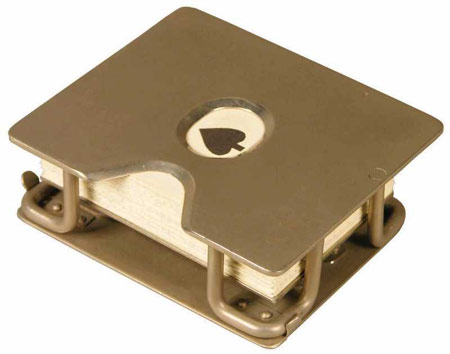 |
Two gaffed dealer’s boxes. The one on the right is a skeleton box.
Shifting Checks
Truly bold dealers may physically move a player’s check from a winning bet to a losing bet! Needless to say, this requires a great deal of dexterity, and is best done when the players are distracted—whether by drink, sudden noise, or “pretty waiter girls.” Nevertheless, some disreputable but highly adroit dealers have mastered the art, especially in conjunction with the other cheats discussed above.
Risks of Cheating
Sophisticated players are aware of most basic dealer deceptions, and would never allow a dealer to use a faro shuffle or employ a mirror box. Still, some “brace joints” are designed to draw in “gulls,” inexperienced players who have little notion about the complexities of faro. This is why drinking is encouraged at faro tables—not only do drunk gamblers risk more, they are less observant of dealer shenanigans. Even an experienced player may be deceived by a good two-card box, but accurate casekeeping is often the cure for sleight-of-hand deception. For this reason, sometimes the dealer and the casekeeper work together to grift a player.
Snaps
Some dealers are itinerant, traveling from place to place with their “snap”—a folding table emblazoned with a faro layout. In truly wretched dives, these dealers are free to bushwhack and bamboozle players at will, employing all manner of deceitful chicanery, as long as they pay a cut to the house.
Skinning Dens
The most flagrant form of faro deception is the “skinning den.” In such an operation, a group of insiders decides to “put up a mug,” or fleece an unknowing player. The mark is lured into a game where everyone is already in the know, and the dealer’s box is rigged. As play proceeds, the “cappers,” or fake players, win or lose accordingly, knowing which bets to make and which to avoid. Meanwhile, the gull just keeps losing! The dealer is never suspected of rank dishonesty because the other “players” seem to be doing fine—surely it’s just a case of bad luck?
Player Cheating
Players may also cheat at faro, but their options are usually limited to surreptitiously changing their placed checks. Such subterfuge is easier when there are multiple players, often clamoring for whiskey or distracting the dealer’s attention. Some talented cheaters attach silk or horsehair threads to their checks, juking their bet from one card to the next when the dealer is distracted. Coppers may also be changed. Of course, more than one amateur has discovered himself staring down the barrel of his dealer’s “equalizer” in this fashion!
Snaking
The most extravagant form of player cheating is “snaking the deck.” This involves stealing the dealer’s deck and returning it marked or otherwise prepared.
Faro game in Bisbee, Arizona 1900
Deadlands Faro
Nothing brings the Wild West alive like a drunken game of faro! To simulate this activity, the Marshal needs a towel, a small box, a handful of poker chips, a rectangle of paper with “HIGH CARDS” written on it, a few pennies, and two decks of cards, preferably the same brand. It’s also nice if the towel is green, and comes wrapped around a bottle of Kentucky bourbon.
Setup
The towel is unrolled to simulate the layout, with the thirteen spades of one deck arranged in the fashion described above. If the Marshal doesn’t mind damaging the cards, a loop of tape helps to secure them to the towel. The “HIGH CARD” rectangle is taped to the top of the layout. The second deck is thoroughly shuffled and placed in the box. (Of course, a dealer’s shoe may be cheaply purchased online.) Chips and pennies are distributed to the players, along with generous dollops of Widow Jane, and the game of faro is ready to begin! Casekeeping may be done by keeping a running tally of the cards on a whiteboard or piece of paper. Alternatively, discarded cards may be simply laid out on the floor in consecutive order.
Rule Variations
Deadlands being a game of alternative history, the Marshal is free to use the traditional faro rules as described above, or may establish any number of variations. For instance, in my personal campaign, a doublet results in the dealer winning all bets placed on that case. This makes faro games tougher, more dramatic, and significantly easier to manage! The Marshal also decides which types of bets are allowed, such as exotic combinations or “Red vs. Black” style variants. Additionally, I recommended that a group play a practice game out of character before role-playing a “real” game of faro. It’s easier to learn the rules and clear up misunderstandings when there’s not a pretend revolver pointed your way!
Gambling Skill
A player character with no Gambling skill may still play faro if the rules are explained, but serves as the perfect “gull” and may not cheat, keep tabs, or make combination bets. A character with Gambling d4 may place all manner of bets. A character with Gambling d6 plays faro regularly, knows how to keep tabs, and would never allow a dealer to shuffle a deck without “snowing out” the cards. A character with Gambling d8 knows how to cheat, and is aware of various gaffed boxes. A character with Gambling d10 is an expert, and may even deal faro professionally. A character with Gambling d12 knows all the rules and variations, and is familiar with every possible method of cheating.
Stakes
To make the simulated game of faro more enjoyable, there should be a contextual meaning within the milieu of the Deadlands campaign. Three suggestions for upping the stakes follow, but clever gamers may certainly think of more!
Faro as Role-Playing Opportunity
The game of faro may be played with chips representing player character’s money, with the stakes of winning or losing enacted in-game as encounters. For instance, maybe the player characters are trying to wrest information from Doc Holliday or Belle Siddons, but they’ll need to first impress the dealer by winning a certain amount of money. This can be especially effective if the player characters cheat, which may lead to a real in-game jackpot, or possibly result in a violent confrontation!
Gambling for Fate Chips
The most simple way to make a game of faro relevant to players is force them to gamble with Fate Chips, whether their remaining chips from this session, or their allotment for the following gaming session. Players may wager their Fate Chips directly as checks, with a win earning an extra Fate Chip, and a loss adding their Fate Chips to the Marshal’s tally. These “lost” Fate Chips may later be used against the players, perhaps distributed as extra “bennies” to various NPC antagonists or monsters during future encounters. The Marshal should limit to the number of player successes, perhaps allowing each player to double their Fate Chips before being forced to “cash out.” To keep the game more active, these fate chips may be combined with regular checks as described above.
Gambling for High Stakes
For more active games of faro that encourage multiple bets, poker chips may be used to symbolize material winnings and losses. Each player is given ten poker chips at the beginning of the faro game. At the end of the game, each player’s number of chips are tallied, and the following table is consulted:
| No Chips | The player loses all their Fate Chips, the next Joker drawn as an Action Card is counted as a Two of Clubs, and the player loses 1 XP. |
| 1 Chip | The player loses all their Fate Chips, and the next Joker drawn as an Action Card is counted as a Two of Clubs. |
| 2–3 Chips | The player loses two Fate Chips, and the next Joker drawn as an Action Card is marked as a Two of Clubs. |
| 4–5 Chips | The player loses two Fate Chips. |
| 6–9 Chips | The player loses one Fate Chip. |
| 10 Chips | Nothing! You broke even, pardner. |
| 11–14 | The player gains one Fate Chip. |
| 15–17 | The player gains two Fate Chips. |
| 18–19 | The player gains two Fate Chips, and the next Deuce drawn as an Action Card is counted as a Joker. |
| 20+ | The player gains two Fate Chips, and the next Deuce drawn as an Action Card is counted as a Joker. Additionally, the player may draw an Adventure Card. |
The Marshal is free to adjust these rewards and penalties; but but Savage Worlds Adventure Cards are always a welcome enticement! The scale may be modified as well. Perhaps each player starts with 20 or 50 chips, with the bonuses and penalties scaled accordingly.
Hangman’s Turn
Western legend contends that a faro dealer Jack King was hanged for murder. For that reason, a turn that produces a Jack and a King is colloquially known as a “Hangman’s Turn.” In a Deadlands faro game, this legend may be exploited for various dramatic opportunities. It should be up to the Marshal to decide, but any turn producing a Jack and a King may have supernatural consequences, especially if the faro game is taking place in a haunted locale.
Cheating
A player character with the Gambling skill may attempt to cheat. The cheater must make an opposed Gambling roll vs. the dealer’s Gambling skill. Modifiers may be applied based on potential distractions. A success allows him to shift one check without detection. A raise lets him shift a check now, and one more at any point later in the game. Additional attempts to cheat during the same game incur a cumulative –2 penalty per attempt. A failure results in the dealer, casekeeper, or lookout catching the cheater red-handed, a situation which must be resolved in-game, preferably with a Colt Navy revolver.
Joker Rule
An alternate mechanic to use for cheating characters is the “Joker Rule.” Prior to launching the faro game, the Marshal shuffles both Jokers into the deck, creating a deck of 54 cards. Whenever a Joker is drawn, it is not counted as part of the turn, but represents an opportunity for the gambling character to make a Gambling roll vs. TN-4. A success allows him to shift a losing bet to a winning one. A failure results in detection. This method makes cheating easier, but limits the opportunity through randomization.
Crooked Marshals
The dealer is also free to cheat, but that should be solely up to the discretion of the Marshal. To be entirely fair, the Marshal should force non-player characters to make the same cheating rolls required by player characters. A success allows the dealer to hide a card or swap two cards; a raise allows the dealer to do this twice during the game. A failure results in the player with the highest Gambling score noticing the subterfuge.
Of course, there’s nothing stopping a Marshal from accurately portraying faro, and operating a rigged game from the get-go! To represent a “gaffed box,” a fixed deck should be prepared, one that features numerous splits clustered together after the initial soda card. A fixed deck should also have a preponderance of turns where a high card is positioned before a low card, just to screw over the saps placing checks on the “High Card” marker. This prepared deck may be hidden away and secretly swapped with a publicly shuffled deck, or, because this is a game-within-a-game, may be triumphantly produced as a fait accompli, with a wink to the players—“Welcome to the world of faro, boys!”
All I shall say in concluding my work will be to repeat Douglas Jerrold’s famous advice to young folks about to marry, applying it to a young man about to tackle the tiger in his lair: Don’t!
—Alfred Trumble, Faro Exposed, Or the Gambler and His Prey, 1882
Sources & Notes
The Wikipedia page on faro is pretty straightforward, but John Sander’s “Faro: Favorite Game of the Frontier” for Wild West magazine is more detailed, and has colorful stories about famous players. Joe Bob Briggs explains faro neatly in “The Vegas Guys: The Ghosts of Faro,” and offers some interesting stories about “the suicide table.” For the deepest dive into the rules and history of faro, you can’t beat Don Meyer’s self-published monograph, The Game of Faro. Meyer’s paper also features a delightful glossary of amazing slang. A solid contemporary resource about faro is the book Sharps and Flats, a famous treatise on gambling published in 1894 by Victorian inventor and séance-debunker John Neville Maskelyne. Not only are the rules cheerfully discussed, but Maskelyne spends several pages enumerating the various methods of cheating. Most of my information about cheating comes from Sharps and Flats, along with the black and white diagrams. There are several YouTube videos about faro, but the most informative are Gather Together Game’s How to Play Faro and The Grifter’s Gameroom Episode 2. You can play faro on your phone, too. Check out this review of the Faro App, with links for iOS and Google.
Image Credits
The painting used in the banner is from a vintage advertisement for Cyrus Noble Whiskey, while the photograph of the “Faro Bank” was taken in 1900 at the Orient Saloon in Bisbee, Arizona. The image of the faro layout is from Wikipedia, but all other black and white illustrations have been borrowed from Maskelyne’s Sharps and Flats. The dealer’s box with the Ace of Spades is from Potter & Potter Auctions, as is the gaffed box with the King of Diamonds. The skeleton box is from the utterly delightful Museum of Crooked Gambling. The photograph of the vintage casekeep was found unattributed on Pinterest. The “Bucking the Tiger” graphic was found on “Faro: A Real Game of Chance” by Colorado Central magazine.
Author: A. Buell Ruch
Last Modified: 21 April 2020
Email: quail (at) shipwrecklibrary (dot) com
PDF Version: [Coming Soon]


